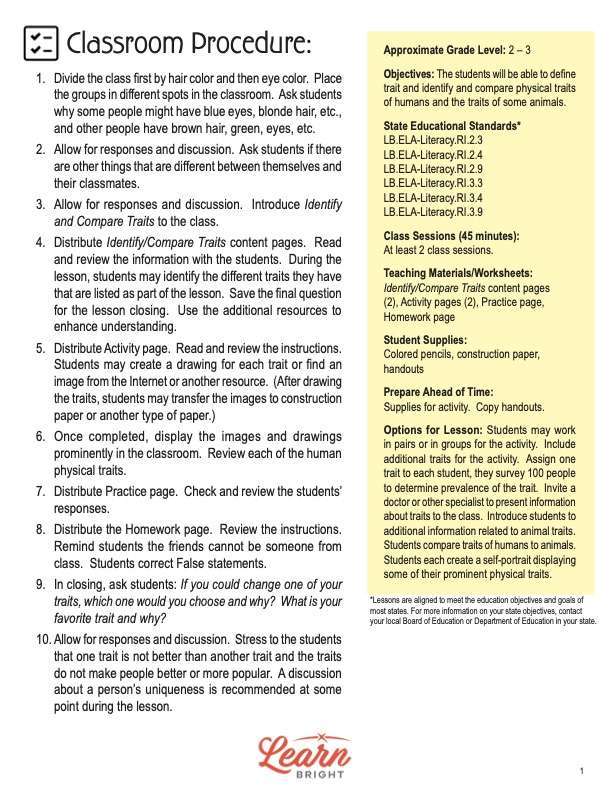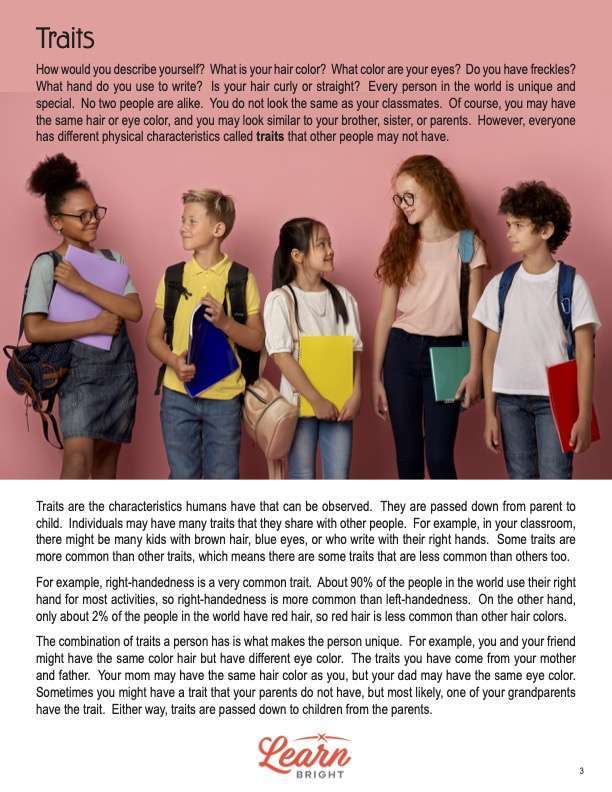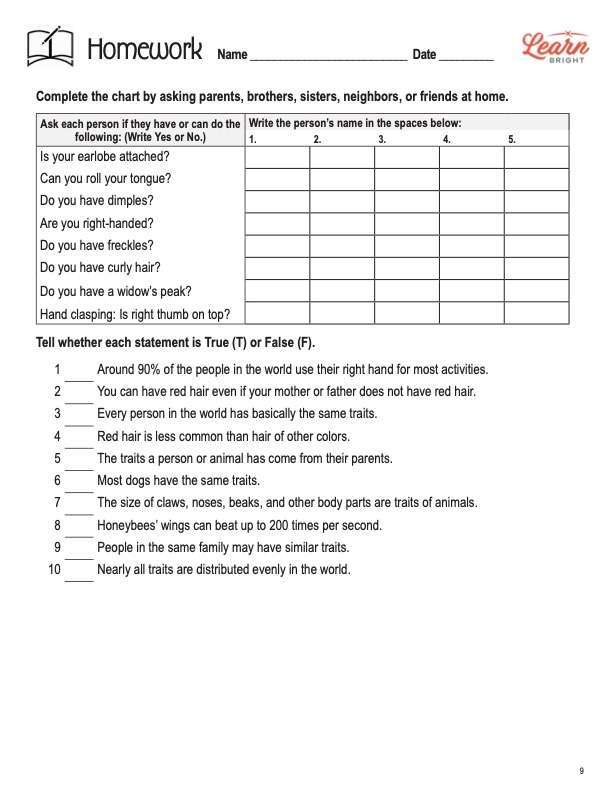Description
What our Identify and Compare Traits lesson plan includes
Lesson Objectives and Overview: Identify and Compare Traits teaches students how to identify specific physical traits in humans. Students will discover why people have unique traits and be able to compare their own with those of their classmates. They will also compare traits in humans the traits that other animals have. This lesson is for students in 2nd grade and 3rd grade.
Classroom Procedure
Every lesson plan provides you with a classroom procedure page that outlines a step-by-step guide to follow. You do not have to follow the guide exactly. The guide helps you organize the lesson and details when to hand out worksheets. It also lists information in the yellow box that you might find useful. You will find the lesson objectives, state standards, and number of class sessions the lesson should take to complete in this area. In addition, it describes the supplies you will need as well as what and how you need to prepare beforehand. In addition the handouts, you will need to provide colored pencils and construction paper.
Options for Lesson
The “Options for Lesson” section lists many suggestions for additional activities or exercises or alternative ways to approach parts of the lesson. One idea is to assign one trait to each students. They will then survey 100 people to determine how prevalent that trait is. Another option is to invite a doctor or other specialist to speak to the class and present information to supplement the lesson. You could also provide students with additional information on animal traits and have students compare humans and animals. Students could create a self portrait that displays some of their common physical traits. Regarding the activity worksheet, students could work in pairs or groups rather than alone, and you could include more traits of which they can draw pictures.
Teacher Notes
The paragraph on this page provides a little extra information as you prepare the lesson. It states that the focus of this lesson is to explain differences in physical traits and only briefly discusses heredity. It suggests that you teach the lesson in conjunction with others that relate to heredity. You can use the lines on this page to write ideas and thoughts you have before presenting the lesson to the class.
IDENTIFY AND COMPARE TRAITS LESSON PLAN CONTENT PAGES
What Are Traits?
The Identify and Compare Traits lesson plan contains three content pages. The lesson starts off with a few questions: How would you describe yourself? What is your hair color? Do you have freckles? Is your hair curly or straight? It explains that every person in the world is unique and special. No two people are alike (although some people can look nearly identical, of course). People might share some similar traits, like the same eye color or hair color. But for the most parts, people have different physical traits that set them apart.
Traits are the characteristics we have that people can observe. They get passed down from parent to child. Students will learn that they might share lots of similar traits with others. In their classroom, for instance, there may be kids with brown hair and blue eyes who write with their right hands. Others have green eyes or black hair or write with their left hands. Some traits are more common than others, and some traits are quite rare.
For example, right-handedness is very common. Nearly 90% of the people in the world use their right hands to write and to do most other activities. As another example, having red hair is not very common at all. Only about 2% of the world’s population have red hair. Red hair, then, is far less common that other hair colors.
Characteristic Combos
The combination of traits a person has is what differentiates them from everyone else and what makes them unique. As an example, the lesson mentions that one person and his friend might have the same hair color but a different eye color. Students will learn that they receive their traits through their parents. They might have the same hair color as their mother but the same eye color as their father. And sometimes, they might not have the eye color of either parent but instead the eye color of a grandparent.
Like humans, any other animal has unique traits as well. Hummingbirds have wings that can beat up to 200 times a second. Honeybees dance to communicate to other bees. A dog’s hearing is four times better than that of a human. Other physical traits of animals include the size of their claws, the shape of their nose or beak, or the length or color of their fur.
The lesson provides a picture of several different dogs. They are all dogs, but they look different because of their unique traits. Some are small while others are quite large. Some of the dogs have really floppy ears while others are stiff instead. A few of the dogs have very short hair. Others have long, curly hair. They also come in lots of different colors.
Human Traits
Apart from hair and eye color or tallness, humans have a wide variety of traits. The lesson provides a list of various unique traits. People’s earlobes are either attached or detached. Attached means that the earlobes connect directly to the side of the head. Detached implies that the earlobes hang freely. Sometimes the lobes will be somewhere between the two. Another trait is tongue rolling. Some people can curl up the sides of their tongues to form a tube shape, which is called tongue rolling. About 70% of people are capable of rolling their tongues, but others cannot. However, there are people who can learn how to do it.
Dimples are another trait. These are small indentations on one or both sides of a person’s mouth. Some people are born with dimples that later disappear as they grow up. Others don’t have dimples at birth but develop them later on during childhood. When it comes to hair, people can have curly hair, straight hair, or something in between. People in some cultures might be more likely to have curly hair or straight hair that the individuals in other cultures.
Other characteristics include freckles, hand clasping, hairline shape, long or short eyelashes, face shape, finger length, and eyebrow thickness. There are so many more physical traits that make people unique. The lesson ends by asking students what trait they would change if they could and why. It also asks what their favorite trait is and why.
IDENTIFY AND COMPARE TRAITS LESSON PLAN WORKSHEETS
The Identify and Compare Traits lesson plan includes three worksheets: an activity worksheet, a practice worksheet, and a homework assignment. Each one helps reinforce students’ grasp of the content. You can refer to the guidelines on the classroom procedure page that outline when to hand out each worksheet to the students throughout the lesson.
DRAW THE TRAITS ACTIVITY
The activity will require students to illustrate the physical traits they learned about. For example, they will have to draw a hairline showing a widow’s peak. They will also have to draw a person with either curly or straight hair. This will be a fun way to demonstrate their understanding of what various traits look like.
IDENTIFY AND COMPARE TRAITS PRACTICE WORKSHEET
The practice worksheet will work a little differently. Instead of drawing pictures, students will fill in the blanks with the correct word. They will have to match a word to the definition they learned for a specific trait. Next, students will answer questions based on the content they learned throughout the lesson.
WHO HAS THE TRAIT? HOMEWORK ASSIGNMENT
The homework assignment asks students to interview others (such as parents or friends) at home. They will write five different people’s names in a chart. They will ask each person to do certain things to determine if they have those traits. For instance, they will ask each person if they can roll their tongue. Afterward, the students will mark 10 statements either true or false.
Worksheet Answer Keys
The last two pages of the PDF are answer keys for the practice and homework worksheets. The correct answers are in red to make it easy to compare them to students’ responses. For the most part, students’ answers should exactly reflect those on these pages. However, the nature of the second half of the practice worksheet and the first half of the homework assignment will warrant some variation. If you choose to administer the lesson pages to your students via PDF, you will need to save a new file that omits these pages. Otherwise, you can simply print out the applicable pages and keep these as reference for yourself when grading assignments.









